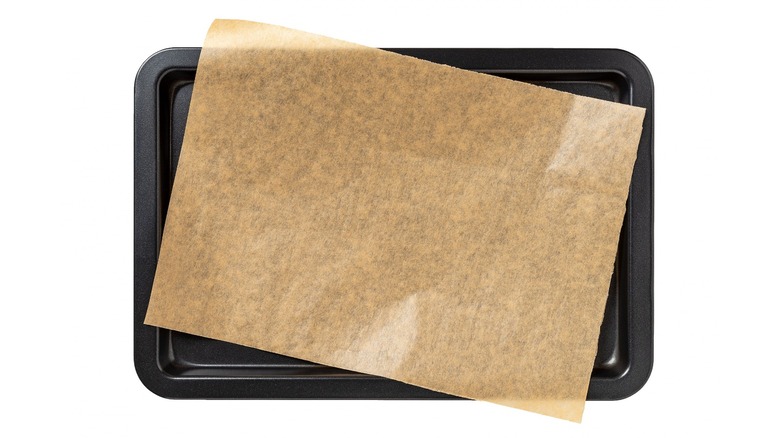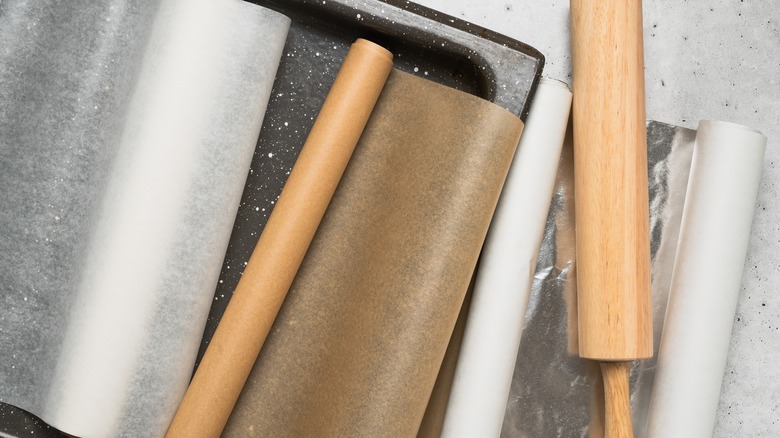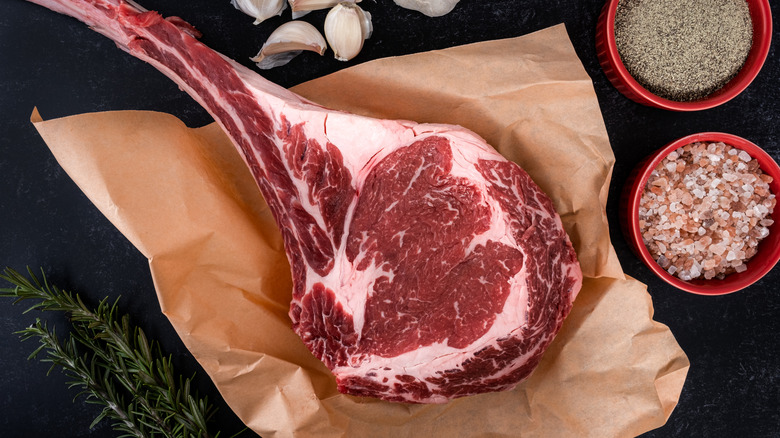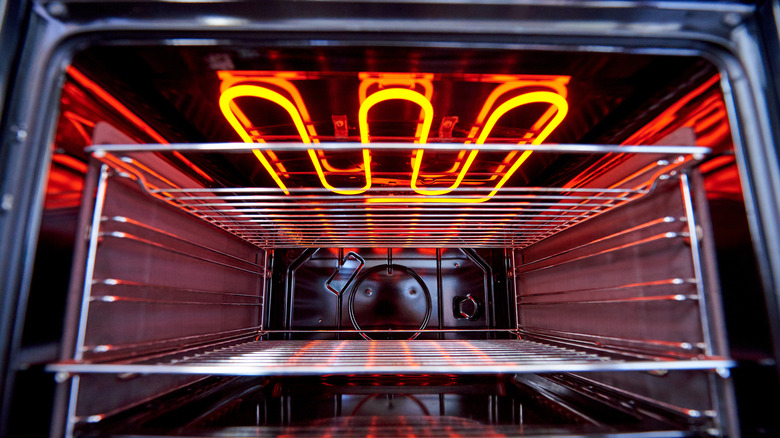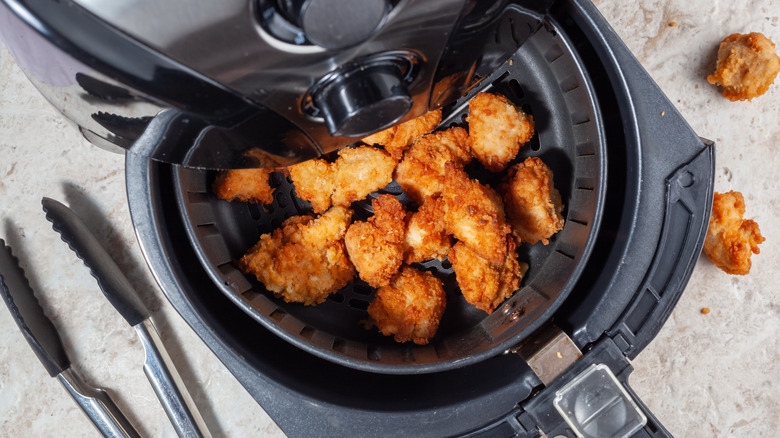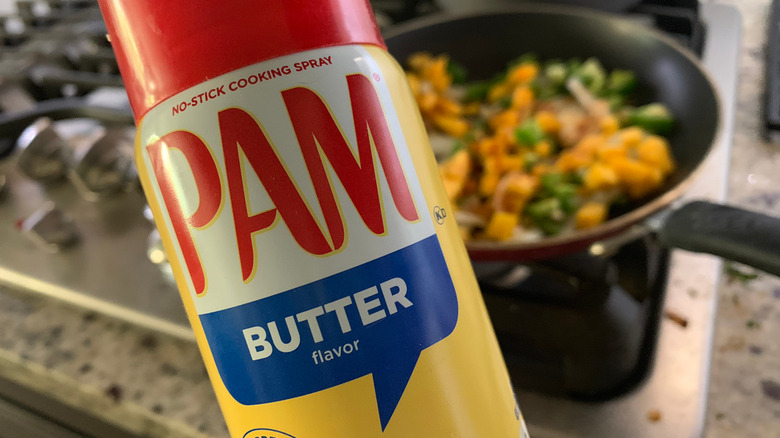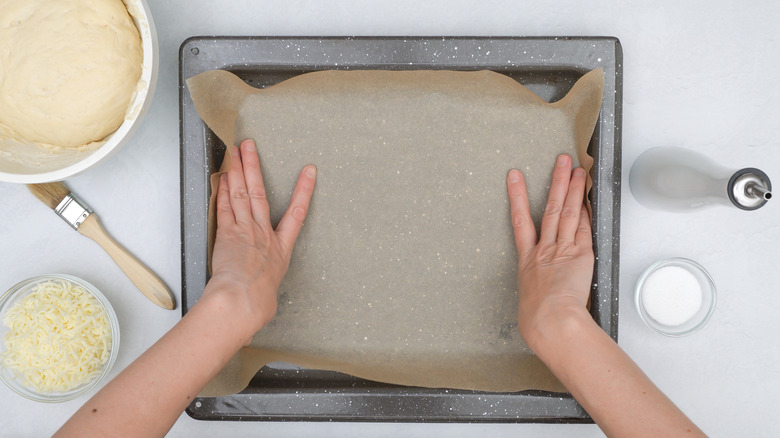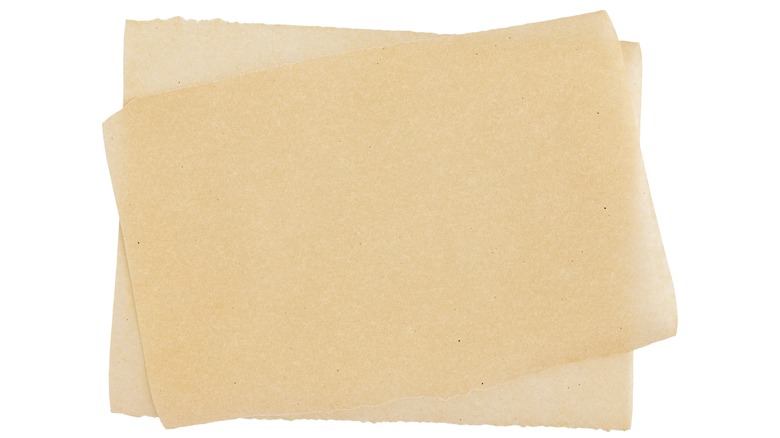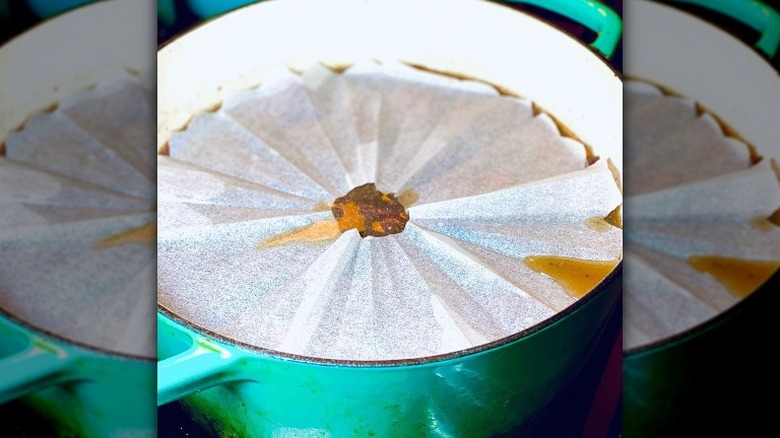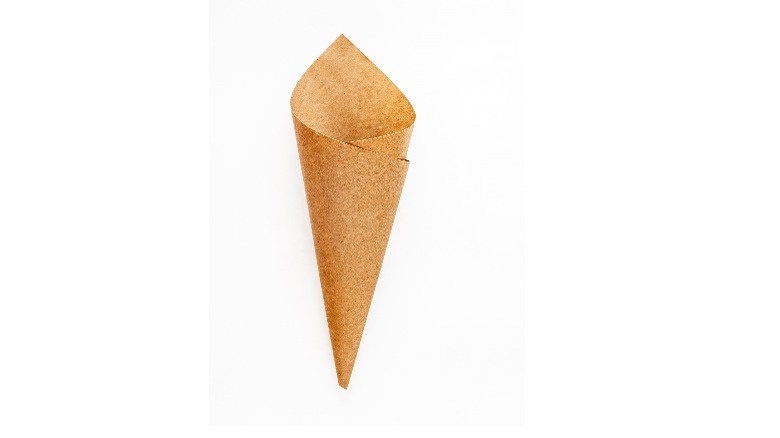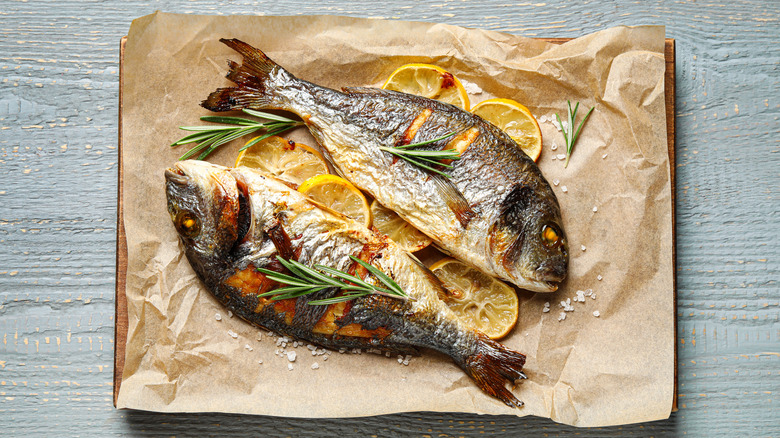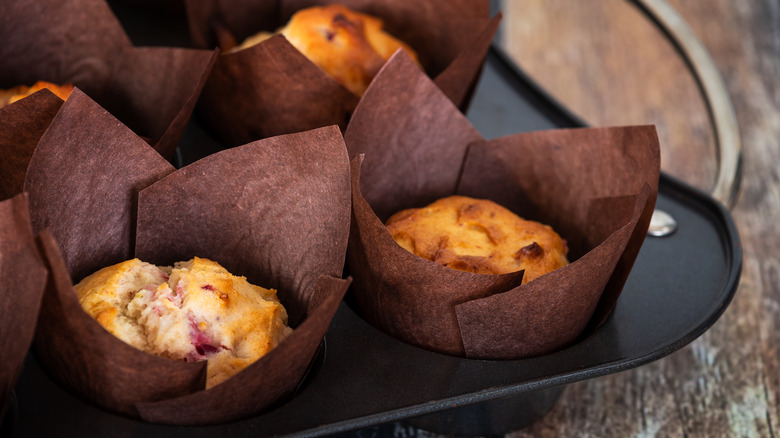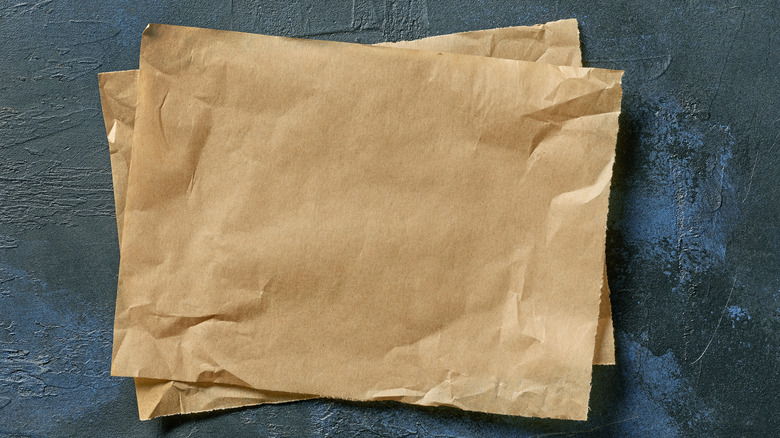Tips You Need When Cooking With Parchment Paper
There's a secret weapon hidden in the back pockets of professional chefs and advanced home bakers, and no, it's not a bench scraper. Parchment paper is a handy kitchen tool that makes baking a breeze and cleaning bulky sheet trays a thing of the past. This special type of paper comes in bleached white or unbleached brown and features a thin coating of silicone that is safe for high oven temperatures and prevents even the stickiest of foodstuffs from attaching. It can come in a roll, or in pre-cut sheets.
Parchment paper is incredibly versatile and works well for cold recipes like chocolate bark, as well as hot recipes like chocolate chip cookies. The uses for parchment paper are virtually endless, and there are a number of key hacks using it that can take your cooking game to a whole new level. Read on for our favorite tips for using this handy kitchen tool.
It's not the same as wax paper
Confusing wax paper and parchment paper can have disastrous consequences. The two types of paper have different coatings: Wax paper is covered in a fine layer of paraffin wax and parchment paper is covered in silicone. The wax paper is perfect for working with super-sticky candy, but will, unfortunately, melt if put in the oven and can lead to burnt paper and ruined pans. Parchment paper is created specifically for use in ovens and is rated to tolerate heat up to 450 F.
Wax paper does have its place, namely for use in a microwave or for catching dry, sifted ingredients. Another common use is for piping buttercream frosting or working with hard candy. Once the confection sets firm, it can be easily removed and transferred to its final home. For any use involving the oven, play it safe and stick to parchment paper.
Or butcher paper
Another common kitchen confusion is the difference between parchment paper and butcher paper. While butcher paper can vary from type to type, typically its intended use is to wrap raw meat and to prevent any associated juices from dripping out. The coating that provides the waterproof barrier is very effective at that, but won't work at all in the oven. The coating on butcher paper is simply not designed to endure the high heat of that cooking medium.
Butcher paper is much better at wrapping food than parchment paper, however, and is designed to protect the food while still allowing for some airflow to prevent a build-up of air or moisture that could contribute to spoiling. Parchment paper has a slick, silicone coating that prevents it from working well as a food wrap. While some things in the culinary world can be substituted, in this case, it's best to pick the right tool for the job.
Don't put it under the broiler
While parchment paper can be a true game-changer when it comes to cooking food in the oven, it does come with some limitations. Most brands state that the paper is safe up to 450 F and that should be enough for the average recipe. However, most ovens have broilers on top that can easily exceed this temperature, especially when the heating element uses gas. Using parchment paper under the broiler is a big no-no and will result in a burnt paper at best, and a kitchen fire at worst.
Parchment paper is still paper, after all, and will burn at high temperatures or when exposed directly to flames. For recipes that call for super-hot temperatures, stick to silicone baking mats or skip the liner altogether. It's better to deal with a bit of food sticking than have a potentially dangerous situation on your hands.
Use it in the air fryer
Air fryers are amazing inventions and one of the best new additions to the world of culinary appliances. While it seems like a piece of technological wizardry, air fryers are really just small convection ovens. The powerful fan constantly circulates hot air and the holes in the basket let that air travel all around the food to allow it to brown on all sides.
While the nonstick coating in most air fryer baskets is enough to avoid sticking with many common foods, there are some recipes (hello, pigs in a blanket) that could potentially cause a bit of an issue. The good news? You can use parchment paper in the air fryer to provide an extra layer of the nonstick coating and for quick and easy cleaning. The only drawback is that the paper will block some of the airflows that occur in the air fryer, so just keep that in mind.
Don't use it for roasting vegetables
Crispy, roasted vegetables are extremely delicious and most of the flavor comes from the deep caramelization that forms when the food makes contact with the pan. Any added oil in between provides the medium for which the oven's heat can be transferred to the vegetables, resulting in that awesome browning. While parchment paper does an excellent job of providing a nonstick barrier and super-easy clean-up, you might want to think twice before using parchment paper for roasting vegetables.
The paper itself is slightly heat resistant due to the silicone coating, and this resistance can be enough to prevent the vegetables from browning in any spots where it makes contact with the pan. The vegetables will still brown on top due to the hot flow of air circulating around, so the pros and cons of using parchment for roasted vegetables vary on a case-by-case basis.
Use nonstick spray to make it stick
Parchment paper can come in several forms, but the one most commonly found in grocery stores comes in a roll. This makes it easy to store, but anyone who has used this type knows it comes with a frustrating drawback. Being stored in a roll makes the paper want to roll back up even after you cut off a sheet. Master chef Alton Brown has a secret trick to making parchment paper stick to baking dishes.
The parchment paper has a coating that is great for keeping food from sticking, however, this same property keeps it from sticking to sheet trays and baking dishes. The solution? Simply spritz your pan with a little water. The paper will stick to the water, and if you use a light hand it won't be enough moisture to dramatically affect the food you're cooking in a negative way. A light coating of nonstick cooking spray will also do the trick!
Keep it from curling
If the required recipe is too delicate to take the addition of water or cooking spray, there's another way to prevent the paper from curling. This one simple step couldn't be easier. All you have to do is simply crumple the paper up into a ball before flattening it back out. The crumbled paper disrupts the tendency for the paper to curl back up and won't disrupt the paper's ability to provide a nonstick barrier between the food and the baking tray or pan.
Now, this technique won't work for everyone. The paper will remain somewhat wrinkled even after being straightened back out and some baked goods will end up with a wrinkled exterior crust after baking. For ultra-delicate recipes like meringue, where it isn't recommended to introduce oil or water and the wrinkles will mess up the final look, you can always dot small amounts in the corners of the tray under the parchment paper to keep it stuck down flat.
Buy it in pre-cut sheets
The absolute best way to keep parchment paper from curling is actually quite simple: Don't buy it in rolls. Amazon and specialty baking stores sell parchment paper in pre-cut sheets, specifically sized to fit in standard baking pans (and even round cake pans). These pre-cut sheets are preferred by restaurants and professional bakeries that do not have time to fuss with annoying, curling parchment paper. Using these sheets is as simple as pulling one from the box and placing it on the baking sheet.
The standard sheet tray size is the most useful for the average home baker, and this size can also be cut down into smaller sizes, and even strips to be used for other purposes. The pre-cut sheets are more economical as well, averaging about $20 for 200 to 300 sheets, as opposed to similar rolls which cost about four times as much, foot for foot.
Learn how to make a cartouche
Making a parchment lid, or cartouche as it is sometimes called, is an essential kitchen trick for any serious cook. This technique is quite simple and might remind you of making a paper snowflake in elementary school. As Jamie Oliver shows us in this video, the technique starts by cutting parchment into a square, then folding that square in half into a triangle, then in half twice more. At this point, it will be a thick but skinny triangle.
Measure the radius of your pot or pan by holding the tip of the triangle over the dead center of the vessel, then marking with your finger where the edge of the pan is. Cut the excess paper off at this point and once you unfold — voila. A perfectly-sized circle. If you need a hole in the middle to vent steam, simply cut the tip off the triangle before unfolding.
Make a quick pastry bag
Another handy bit of culinary origami is the parchment pastry bag or piping cone. Perhaps you find yourself fresh out of pastry bags right in the middle of a tricky project, or maybe you only need to pipe a tablespoon or so of icing for lettering on a cake. Either way, the parchment pastry bag is a handy trick that any cook or baker should know.
As Kelly Senyei shows us in this video, the parchment bag starts with a large triangle that gets folded around itself. The tail folds over on the cone to "lock" it all together. Some bakers prefer to finish the bag by folding the top over a few times so no product can escape out the top. This trick can be handy in a pinch but works much better with small amounts of icing or melted chocolate. Large amounts of frosting are much better off in a true pastry bag.
Use it to cook fish
Cooking fish en papillote, or "in paper," is a fancy bit of French culinary fanciness that looks much more difficult than it actually is. Cooking fish en papillote is actually extremely easy and can be used for all kinds of fish. The technique is simple: Place fish and flavoring ingredients into parchment paper, seal it with egg white (which acts as a glue of sorts), and place it in the oven. The steam from the fish and other ingredients as the oven heats up fills the bag and cooks whatever is inside.
This method requires a bit more up-front commitment in terms of preparation, but the payoff comes later when clean-up is as simple as tossing the parchment paper. Cooking food en papillote is also a remarkably low-fat cooking method but still manages to be more flavorful than simply steaming as the flavors are trapped within the paper as the food cooks.
Make the perfect cupcake liners
Let's face it. No one is a fan of annoying single-use items in the kitchen. One of the worst offenders might be muffin liners, those superfluous, ridged bits of paper that allow muffins and cupcakes to pop right out of the pan. Yes, you could always just use nonstick baking spray, but there's another solution as well. A popular TikTok video demonstrates another ingenious way to use parchment paper as a replacement for muffin liners.
This method allows you to avoid having to run to the store just to get this one specific baking tool. Simply cut a few squares of parchment paper, make the appropriate folds, and pop them into the muffin tray. The look of the parchment definitely lends a more sophisticated, professional bakery element to any baked good, plus you can avoid the addition of dyes or bleach that are often found in muffin liners.
Reuse your sheets
Using parchment paper might seem wasteful compared to reusable alternatives like silicone baking sheets. While there will always be some waste with disposable products, you can stretch your parchment paper further by reusing it more than once. There are limitations, of course, but tray after tray of cookies can be baked on the same piece without taking out a new one. The trick with this tip is to consider the food you are cooking on the parchment and make an educated assessment from there.
Any parchment that has burnt on food residue is probably destined for the trash, as well as any recipes with excessive amounts of oil. Sheets that are mostly dry or only have trace amounts of cooking spray can be folded up and saved. There's no hard and fast rule when it comes to the number of times, but eventually, the paper will get very dry, crinkly, and prone to cracking.
